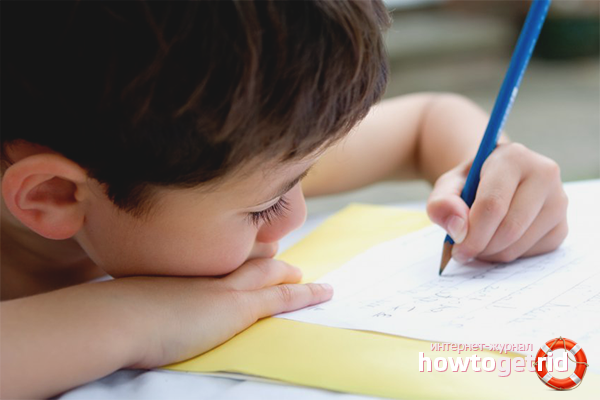The content of the article
Dysgraphia (impaired handwriting) is a common problem in both adults and children. But if an adult can consciously control the tidiness of his handwriting and has learned to parse written by other people, then children do not possess this ability. It is important in early childhood to instill in the child a hunt for beautiful writing: this is useful for him, as he will be able to make out what is written by himself, and for those around him - the same teachers - who will read the sheets written with a child’s hand.
Beautiful and legible handwriting is a big plus from all sides. You understand that you write, the people around you also understand, and from an aesthetic point of view - it’s nice to see neatly drawn letters, not scribbles that even the author cannot make out.
Rate the importance of the problem
Without the realization that dysgraphia is a matter that should be seriously considered, nothing will come of it from the beginning. If you notice that your child writes extremely illegibly and dismissed it, justifying yourself by learning at school, you are fundamentally wrong! He will not learn, because handwriting is a matter of habit. And the older the person, the more difficult it is to somehow correct this habit.
To make sure that your child is accustomed to beautiful spelling, read the following:
- Grades in primary school teachers are most often set for calligraphy. A reduced grade with a correctly completed task raises a logical question to which the teacher will answer that the child wrote inaudible / inaccurate / made too many blots. The teacher is right in this case: after all, it is in his interests so that his students write clearly. If you do not want to see a child saddened by an undervaluation, teach him to write beautifully and accurately!
- In this age of computer technology, many people, relying on the artificial intelligence of machines that automatically correct errors and place commas, do not develop the writing skills as such. In the future, this turns into incidents with documents that need to be filled out by hand: blots, "dancing" letters and the signature of "chicken paw." To prevent this from happening, it is necessary to instill in the child the habit of writing, not printing. Learning to type can be easy, since calligraphy is not important here, but writing to learn is difficult, but this skill is needed in life.
- No matter how teachers want each child to write accurately and legibly, in modern schools too few hours are allocated to the basics of calligraphy, for which it is absolutely impossible to learn how to draw letters correctly. Take care of the child at home alone. Believe me, he will thank you for that.
Reasons for Bad Handwriting
Improper posture is the most common reason for crooked handwriting, in our opinion. With an improper sitting position, the hands, as a rule, are in an extremely uncomfortable position, so instead of beautiful letters on the sheet various kinds of squiggles appear:
- The child writes the letters “n”, “k”, “and”, “p” so that they cannot be distinguished from each other;
- Letters, contrary to the ruler, “fall” under the line or “fly up” above it;
- In the letters "w" and "m" the child draws extra curls.
Rules for proper fit:
- the child sits with a flat back, shoulders and neck are relaxed, but not twisted;
- hands are on the table, but the elbows do not touch its surface;
- between the countertop and chest, the distance is equal to the palm of your hand, parallel to the surface of the table
- legs stand flat on the floor or on a special stand (you cannot cross them or throw one on the other - this bends the spine).
Having accustomed the child to the correct sitting position, you will initially contribute to his beautiful handwriting: the child will not be pinched in an uncomfortable position, and the hand will calmly slide on paper, displaying neat letters.
Another reason is undeveloped motility (especially fine). Here we are talking about a few inhibited movements of the fingers and hands, which is why the joints do not work at full strength, and the child does not have the flexibility to write neat letters.
- The child incorrectly displays rounded letter elements;
- The schoolchild’s letters are not just ugly, but incorrectly written;
- All letters are of different sizes, and there are a lot of blots on the sheet.
In this case, it is worth thinking about conducting gymnastics with the child for the wrists and fingers: usually in elementary school teachers conduct it before the start of classes.
Try to give your child small objects, collect mosaics from small parts with him - all this develops fine motor skills and improves handwriting.
The following factors speak of poor spatial perception (non-orientation in space):
- Different spacing between letters in one word;
- Different spacing between words in one line;
- The child confuses the letters in the word, rearranging them, or writes them in mirror image;
- When writing words, the child goes beyond the fields of the notebook.
In this situation, games will help again. Ask him to repeat the movements of his right hand in the air with his left hand (for example, you can write the same letters) or play “Find a prize” with the child, where he must follow your instructions exactly to find a small present.
How to solve the problem of ugly handwriting
Having dealt with the causes of the ugly handwriting, you should proceed to their solution.
- As already mentioned, it is necessary to teach to sit correctly and evenly.
- Actively develop fine motor skills: collect mosaics, cut, make applications, collect origami, draw, hatch, weave bracelets from threads, etc.
- Buy a child a copy-book: in them he can write with a soft pencil and a pen. Copybooks should choose those in which the pale dotted line indicates the outline of a letter or word that the child should circle with his hand. Copybooks are also suitable, where after a printed letter or word there is a space intended for the child to repeat his writing.
- Classes in spelling and calligraphy should be held every day for 15-30 minutes. Make sure that the child does not get sore fingers from zeal.
- Teach you how to keep writing instruments. For the initial stage of training, a pen in which special notches for the fingers are made is quite suitable. The handle lies on the upper phalanx of the middle finger, and the thumb and index finger tightly grab it, while the thumb is above the index finger. The tip of the writing instrument is directed strictly to the shoulder. The length of the pen or pencil should not exceed 15 cm.
- Notebook always lies at an angle of about 25º relative to the edge of the table.
- The writing desk and chair on which the child sits should correspond to his height.
- Never rush a child - it will only worsen the handwriting! First, he must learn to write beautifully, and after that - quickly. Speed will come with time, the main thing is to regularly devote time to calligraphy lessons.
- Find an incentive if your child point blank refuses to do calligraphy. Never force him to do something, because it will not take success.
- Never scold or punish your child for failure: not everything works the first time. And in no case do not start comparing him with other children - this will only underestimate his self-esteem and repel the whole desire for learning.
- Observe the regime of work and rest.
Learning stages
- Outline Outlines. In special copybooks there are not only letters, but also various figures, patterns, etc., printed with a dotted line.
- Writing letters, their combinations and individual words on the model (special copybooks, which were mentioned in paragraph 3 of the previous section);
- Rewrite individual words, sentences and texts in a lined notebook.
- Fixing in the form of everyday writing in a notebook a paragraph from a story.
Never push your child: the time it takes for him to learn beautiful writing is individually. Be patient, follow the tips you read, and then at school your child will not have problems with calligraphy!
Video: the child will become an excellent student if he writes beautifully












Submit